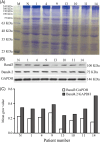A clinical and experimental study of adult hereditary spherocytosis in the Chinese population
- PMID: 32133777
- PMCID: PMC11896511
- DOI: 10.1002/kjm2.12198
A clinical and experimental study of adult hereditary spherocytosis in the Chinese population
Abstract
Hereditary spherocytosis (HS) is often misdiagnosed due to lack of specific diagnostic methods. Our study summarized clinical characteristics and described the diagnostic workflow for mild and moderate HS in Chinese individuals, using data from 20 adults, 8 of whom presented a familial history for HS. We used scanning electron microscopy (SEM) to diagnose HS. We observed reduced eosin maleimide fluorescence activity (5.50 mean channel fluorescence (MCF) units) in the 10 cases of HS, which differed significantly when compared with 10 normal adults (15.50 units), iron deficiency anemia (15.50 MCF units), and megaloblastic anemia (12.00 MCF units) values (P < .05). Next generation sequencing results revealed that 9 out of 10 patients were found to have mutations in the spectrin alpha chain (SPTB), anchor protein (ANK1), and SLC4A1 genes. These mutations were not reported in the Human Gene Mutation Database (HGMD), 1000 human genome, ExAC, and dbSNP147 databases. Splenectomy proved to be beneficial in alleviating HS symptoms in 10 cases. It was found that for the diagnosis of HS, SEM and next generation gene sequencing method proved to be more ideal than red blood cell membrane protein analysis using sodium dodecyl sulfate polyacrylamide gel electrophoresis and western blotting.
Keywords: SLC4A1; ankyrin; hereditary spherocytosis; spectrin; splenectomy.
© 2020 The Authors. The Kaohsiung Journal of Medical Sciences published by John Wiley & Sons Australia on behalf of Kaohsiung Medical University.
Conflict of interest statement
The authors declare no potential conflict of interest.
Figures




Similar articles
-
Exome sequencing confirms molecular diagnoses in 38 Chinese families with hereditary spherocytosis.Sci China Life Sci. 2018 Aug;61(8):947-953. doi: 10.1007/s11427-017-9232-6. Epub 2018 Mar 19. Sci China Life Sci. 2018. PMID: 29572776
-
Mutational characteristics of ANK1 and SPTB genes in hereditary spherocytosis.Clin Genet. 2016 Jul;90(1):69-78. doi: 10.1111/cge.12749. Epub 2016 Mar 15. Clin Genet. 2016. PMID: 26830532
-
Identification of new mutations in patients with hereditary spherocytosis by next-generation sequencing.J Hum Genet. 2020 Apr;65(4):427-434. doi: 10.1038/s10038-020-0724-z. Epub 2020 Jan 24. J Hum Genet. 2020. PMID: 31980736 Clinical Trial.
-
[Molecular mechanism of hereditary spherocytosis].Pol Merkur Lekarski. 2006 Jan;20(115):112-6. Pol Merkur Lekarski. 2006. PMID: 16617750 Review. Polish.
-
[Characteristics of hereditary spherocytosis].Nihon Naika Gakkai Zasshi. 1999 Sep 10;88(9):1825-33. Nihon Naika Gakkai Zasshi. 1999. PMID: 10581770 Review. Japanese. No abstract available.
Cited by
-
Integrative preimplantation genetic testing analysis for a Chinese family with hereditary spherocytosis caused by a novel splicing variant of SPTB.Front Genet. 2023 Sep 18;14:1221853. doi: 10.3389/fgene.2023.1221853. eCollection 2023. Front Genet. 2023. PMID: 37795245 Free PMC article.
-
Identification of a novel heterozygous SPTB mutation by whole genome sequencing in a Chinese patient with hereditary spherocytosis and atrial septal defect: a case report.BMC Pediatr. 2021 Jun 28;21(1):291. doi: 10.1186/s12887-021-02771-4. BMC Pediatr. 2021. PMID: 34182956 Free PMC article.
-
Coinheritance of hereditary spherocytosis with haemochromatosis: next-generation sequencing reveals.BMJ Case Rep. 2024 Jan 9;17(1):e256891. doi: 10.1136/bcr-2023-256891. BMJ Case Rep. 2024. PMID: 38195192
-
Genetic mutation analysis of hereditary spherocytosis in Guangxi Zhuang Autonomous Region.J Hematop. 2023 Jun;16(2):95-101. doi: 10.1007/s12308-023-00545-8. Epub 2023 May 5. J Hematop. 2023. PMID: 38175446
-
Identification of a novel ANK1 mutation in a Chinese family with hereditary spherocytosis: A case report.Exp Ther Med. 2022 Nov 16;25(1):4. doi: 10.3892/etm.2022.11704. eCollection 2023 Jan. Exp Ther Med. 2022. PMID: 36561627 Free PMC article.
References
MeSH terms
Substances
Grants and funding
LinkOut - more resources
Full Text Sources
Miscellaneous

